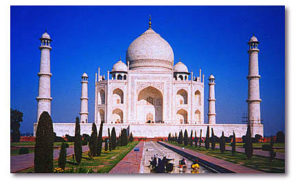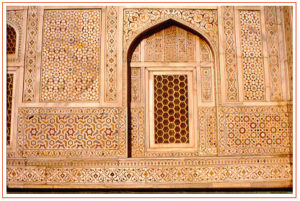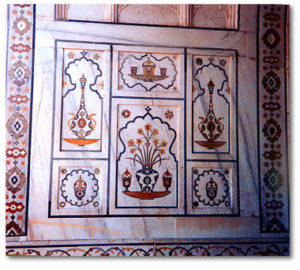The Taj Mahal in Agra is indisputably the most famous example of Mughal architecture. Described by Rabindranath Tagore as “a tear on the face of eternity”, it is in popular imagination a veritable “wonder of the world”.
The white-splendored tomb was built by Emperor Shah Jahan in the memory of his favourite wife, Arjumand Banu Begum, better known as Mumtaz Mahal (“Chosen of the Palace”). She married Shah Jahan in 1612 to become his second wife and inseparable companion, and died in childbirth at Burhanpur while on a campaign with her husband in 1629. Shah Jahan was, it is said, inconsolable to the point of contemplating abdication in favour of his sons. The court went into mourning for over two years; and Shah Jahan decided to commemorate the memory of Mumtaz with a building the like of which had never been seen before.
The dead queen was brought to Agra and laid to rest in a garden on the banks of the Jamuna river. A council of the best architects was assembled to prepare designs for the tomb. Though some attribute the design to Geronimo Verroneo, an Italian in the Mughal service, evidence suggests that it was designed by Ustad Isa Khan Effendi, a Persian, who assigned the detailed work to his pupil Ustad Ahmad. The dome was designed by Ismail Khan.
The tomb which is higher than a modern 20-storey building took 22 years to complete with a workforce of 20,000. Craftsmen from as far as Turkey came to join in the work. The marble was quarried at Makrana near Jodhpur in Rajasthan. Precious stones were imported from distant lands. A two mile ramp was built to lift material up to the level of the dome. It is alleged that on its completion, Shah Jahan ordered the right hand of the chief mason to be cut off so that the masterpiece could never be recreated. As one might expect, numerous other legends are associated with the Taj Mahal: thus, according to one story, Shah Jahan desired to have another Taj built across the river, this one entirely in black marble.
The tomb was provided with sumptuous fittings and furnishings, including rich Persian carpets, gold lamps and candlesticks. It is reliably reported and documented that two great silver doors to the entrance were looted and melted down by Suraj Mal in 1764, and a sheet of pearls that covered the sarcophagus was carried off by Amir Husein Ali Khan in 1720. In a manner of speaking, the pillage of the Taj continues unabated: more recently, the fumes from the surrounding industries have started deteriorating the marble, though various court orders have resulted in industries around the Taj being moved to more distant points. The latest desecration of the monument took place, ironically, in celebration of the fiftieth anniversary of Indian independence, when the mediocre rock star Yanni, whose elevator music has attracted a world-wide audience, was allowed to give a live and certainly unprecedented performance at the Taj.
The surroundings of the Taj Mahal have been restored to the original designs of Ali Mardan Khan, a noble at Shah Jahan’s court. The main vista is accentuated by a red sandstone channel set between rows of cypress trees. The main entrance is from the west, but there are two other entrances — from the east and from the west. The main gateway is a large three-storey sandstone structure with an octagonal central chamber with smaller rooms on each side. The walls are inscribed with verses from the Quran.
The Makrana white marble of the Taj Mahal assumes subtle variations of light, tint and tone at different times of the day. At dawn it assumes a soft dreamy aspect; at noon, it appears to be a dazzling white, and in the moonlight the dome looks like a huge iridescent pearl. Not surprisingly, then, the Taj is today regarded all over the world as a supreme labour of love.
Though the architectural history of the Taj has received much attention, a cultural and political interpretation of the Taj has never been attempted. While it never fails to move and dazzle, one can scarcely forget that its history, like that of other monumental achievements of pre-modern (and even modern) states, is bound to oppression and slavery. Who thinks of the large force of serfs whose labor was exploited to satisfy the love of one man, and how brutal was the repression of the peasantry in order to increase the revenues of the state? Or consider this: is it not oppressive that the Taj charges an admission fee of Rs. 100, an amount that the majority of Indians still do not make in one day’s work, for the luxury of viewing it by moonlight? The monument remains the supreme icon of India to the rest of the world, along with the over-population, notorious poverty, and “mysticism” of this ancient land. It is one of India’s largest tourist-revenue earners, and no tourist image predominates as that of the visitor snapped in front of the Taj. The image of the Taj appears in countless advertisements, and the Taj has taken on another life of its own. Thus a history of the representations of the Taj is still wanting.
Sources
Davies, Philip. The Penguin guide to the monuments of India, Vol II. London: Viking, 1989.
Tadgell, Christopher. The History of Architecture in India. London: Phaidon Press, 1990.




